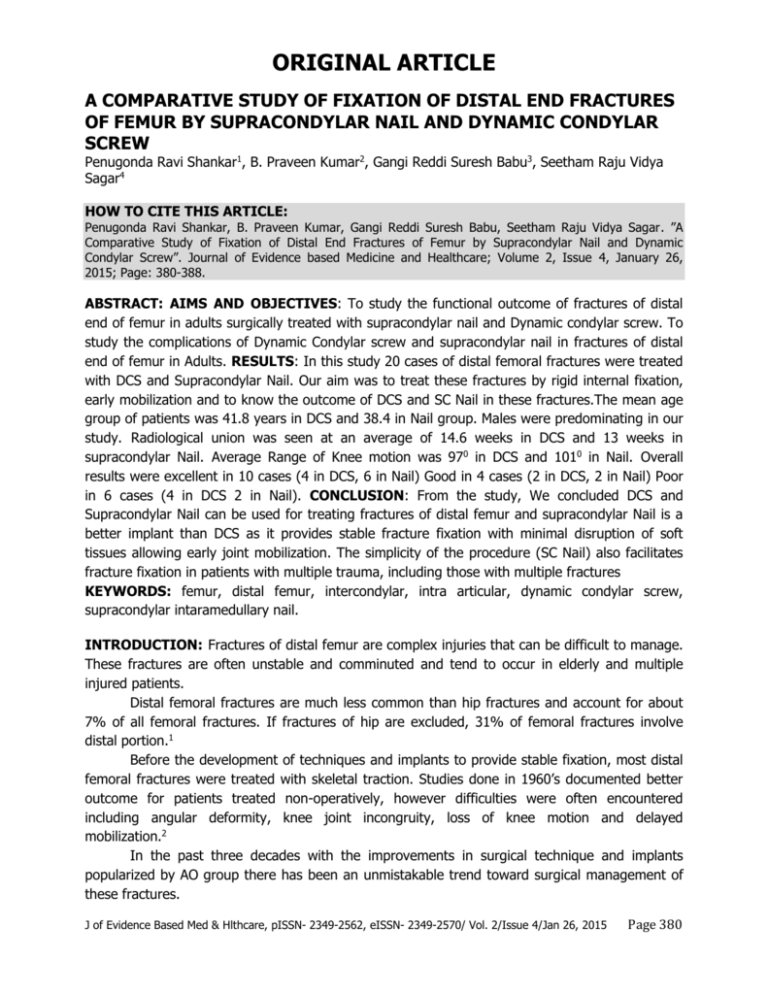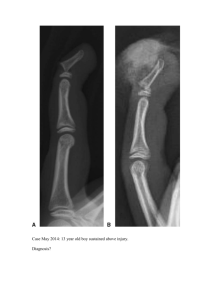A COMPARaTIVE STUDY OF FIXATION OF DISTAL END
advertisement

ORIGINAL ARTICLE A COMPARATIVE STUDY OF FIXATION OF DISTAL END FRACTURES OF FEMUR BY SUPRACONDYLAR NAIL AND DYNAMIC CONDYLAR SCREW Penugonda Ravi Shankar1, B. Praveen Kumar2, Gangi Reddi Suresh Babu3, Seetham Raju Vidya Sagar4 HOW TO CITE THIS ARTICLE: Penugonda Ravi Shankar, B. Praveen Kumar, Gangi Reddi Suresh Babu, Seetham Raju Vidya Sagar. ”A Comparative Study of Fixation of Distal End Fractures of Femur by Supracondylar Nail and Dynamic Condylar Screw”. Journal of Evidence based Medicine and Healthcare; Volume 2, Issue 4, January 26, 2015; Page: 380-388. ABSTRACT: AIMS AND OBJECTIVES: To study the functional outcome of fractures of distal end of femur in adults surgically treated with supracondylar nail and Dynamic condylar screw. To study the complications of Dynamic Condylar screw and supracondylar nail in fractures of distal end of femur in Adults. RESULTS: In this study 20 cases of distal femoral fractures were treated with DCS and Supracondylar Nail. Our aim was to treat these fractures by rigid internal fixation, early mobilization and to know the outcome of DCS and SC Nail in these fractures.The mean age group of patients was 41.8 years in DCS and 38.4 in Nail group. Males were predominating in our study. Radiological union was seen at an average of 14.6 weeks in DCS and 13 weeks in supracondylar Nail. Average Range of Knee motion was 970 in DCS and 1010 in Nail. Overall results were excellent in 10 cases (4 in DCS, 6 in Nail) Good in 4 cases (2 in DCS, 2 in Nail) Poor in 6 cases (4 in DCS 2 in Nail). CONCLUSION: From the study, We concluded DCS and Supracondylar Nail can be used for treating fractures of distal femur and supracondylar Nail is a better implant than DCS as it provides stable fracture fixation with minimal disruption of soft tissues allowing early joint mobilization. The simplicity of the procedure (SC Nail) also facilitates fracture fixation in patients with multiple trauma, including those with multiple fractures KEYWORDS: femur, distal femur, intercondylar, intra articular, dynamic condylar screw, supracondylar intaramedullary nail. INTRODUCTION: Fractures of distal femur are complex injuries that can be difficult to manage. These fractures are often unstable and comminuted and tend to occur in elderly and multiple injured patients. Distal femoral fractures are much less common than hip fractures and account for about 7% of all femoral fractures. If fractures of hip are excluded, 31% of femoral fractures involve distal portion.1 Before the development of techniques and implants to provide stable fixation, most distal femoral fractures were treated with skeletal traction. Studies done in 1960’s documented better outcome for patients treated non-operatively, however difficulties were often encountered including angular deformity, knee joint incongruity, loss of knee motion and delayed mobilization.2 In the past three decades with the improvements in surgical technique and implants popularized by AO group there has been an unmistakable trend toward surgical management of these fractures. J of Evidence Based Med & Hlthcare, pISSN- 2349-2562, eISSN- 2349-2570/ Vol. 2/Issue 4/Jan 26, 2015 Page 380 ORIGINAL ARTICLE There are various treatment options available for management of these injuries, despite the advances in techniques and improvement in surgical implants, treatment of distal femoral fractures remains a challenge. The goal in treating supracondylar and intercondylar femur fractures, as with any periarticular fracture in a weight bearing bone is restoration of a stable limb for functional, pain free ambulation. Maintaining Anatomic alignment, length and preventing stiffness restore function of knee joint. Dynamic condylar screw provides freedom in plane of flexion and extension hence is technically less demanding than fixed angle device. It provides interfragmentary compression.3 The advantages of supracondylar nail include a reduction in operating time and blood loss with reduction of devascularization of fracture fragments. In cases with severe metaphyseal comminution Supracondylar nailing offer a more biological method of fixation with less devitalisation of soft tissue. Fixation of intercondylar fractures is also possible with additional compression screws to stabilize the intra articular fragments. Meta physeal fragments are left undisturbed, which limits need for bone grafting.4 In this study we report the result of surgical management of distal femoral fractures in adult using Dynamic Condylar screw and supracondylar nail. MATERIAL AND METHODS: Twenty patients having distal femoral fractures were treated by open reduction and internal fixation with the dynamic condylar screw system and supracondylar nail during the period from August 2009 to July 2011 and followed up to November 2011 at S. V. R. R. General Hospital attached to S.V. Medical College, Tirupathi. All the 20 patients (DCS-10, SUPRACONDYLAR NAIL-10) were available for the study and follow-up for minimum of 8 months and maximum duration is 2 years. Inclusion Criteria included both fresh and old cases of distal femoral fractures which are of closed type, all supracondylar and intercondylar extension of distal femoral fractures. Exclusion Criteria included Age below 18 years, Patients not willing for surgery, Patients not medically fit for surgery, C3 fractures were not included in the study. All the patients were brought to casualty. A careful history was elicited from the patient and/or attenders to reveal the mechanism of injury and the severity of trauma. Clinical assessment of skeletal and soft tissue injuries and general condition was done. The patients who had supracondylar and intercondyiar fractures of distal 15 cm of femur were selected for the study. As soon as the patient with suspected distal femoral fracture was seen, necessary clinical and radiological evaluation was done and admitted to ward after necessary resuscitation and splintage with either skin or skeletal traction. Associated injuries were evaluated and treated simultaneously Muller's classification was used. There were 18 men and 2 women with an average age of 40.4 years ranging from 23 years to 61 years. The mode of injury was traffic accident in 17 patients, fall in 3 patients. All these injuries were managed according to standard treatment protocol followed in our institution". J of Evidence Based Med & Hlthcare, pISSN- 2349-2562, eISSN- 2349-2570/ Vol. 2/Issue 4/Jan 26, 2015 Page 381 ORIGINAL ARTICLE Once the general condition of the patient was stabilized, definitive treatment was planned. Pre-operatively routine blood and urine examinations were done i.e. Haemoglobin percentage, total WBC count, differential count, erythrocyte sedimentation rate, Fasting blood sugar, blood urea, serum creatinine, HIV, HBSAg, Urine for sugar, albumin and microscopy. ECG was done for all patients. Patients were shown to physician regarding fitness for surgery. Patient status for anaesthesia was assessed by anaesthetist one day before operation. If required pre-operative blood transfusion was given. Results were assessed by criteria recommended by schatzkar and lambert. RESULTS: This series consists of 20 cases of distal femur fracture treated surgically by DCS and supracondylar Nail, 10 each, between August 2009 to July 2011 and followed up to November 2011. 1. AGE DISTRIBUTION: The average age was 41.8 years (DCS) AND 38.4 years Nail. 2. SEX DISTRIBUTION: There were 18 Male patients 2 Female patients 3. MODE OF INJURY: Most of cases were due to Road Traffic Accident. Three were due to fall from height. 4. SIDE AFFECTED: Left femur was involved in 8 cases Right involved in 12 cases 5. TIME OF ADMISSION: 13 Patients presented on same days of injury. 7 patients presented between 1 to 4 days 6. FRACTURE CLASSIFICATION: No. of patients in each fracture group. No. of Patients Percentage DCS Nail DCS Nail A1 3 2 30 20 A2 3 2 30 20 A3 4 5 40 50 C1 C2 1 10 C3 Total 10 10 100 100 Table 1 Type 7. STATISTICS OF SURGERY: Surgery was done 3 days – 14 days after admission at an average of 10 days. All the cases were operated under spiral Anaesthesia. Average duration of surgery was 110 minutes for DCS and 90 minutes for Nail. 8. COMPLICATIONS: 8.1. Intra-Operative: 8.1a Shortening: Shortening of 1cm occurred in 3 patients in DCS group and 2 patients in Nail group post operatively. Shortening was mainly due to commination. In all cases fracture type was type A3. 8.2. Post-operative: J of Evidence Based Med & Hlthcare, pISSN- 2349-2562, eISSN- 2349-2570/ Vol. 2/Issue 4/Jan 26, 2015 Page 382 ORIGINAL ARTICLE 8.2a An Infection: There was one case of superficial infection and one case of deep infection in DCS group. There was one case of deep infection in nail group. Deep infection was controlled after removal of implant after 1 year in DCS group. One patient in Nail group developed infection after 2 months. 8.2b Deformity: One patient had valgus deformity of 150 in DCS group. 9. TIME OF DISCHARGE: Most of the patients were discharged after 10 days of operation after suture removal they were advised on active ROM exercises, not to bear weight and to come for follow up after 4 weeks. One patient who had wound infection was discharged 24 days after surgery in DCS group. 10. CONDITION AT DISCHARGE: For all patients wound is healed well except one who had deep infection. All patients were ambulant using walkers. 11. FOLLOW UP PERIOD: The follow up was available in all patients and ranged from 3 months to two year. 12. RADIOLOGICAL UNION: Time to healing, defined as the time of the formation or circumferential bridging callus across the fractures. The average time of healing was In DCS - 14.6 Weeks. In S.C. Nail - 13.0 Weeks. 13. WEIGHT BEARING: The duration of non–weight bearing ranged from 4-6 weeks. This was followed by partial weight bearing till the signs of radiological union were seen after which full weight bearing was allowed. Initiation of visible callus was early in nail group. The average time for full weight bearing was DCS - 12 Week. Nail - 11 Weeks. 14. FUNCTIONAL RESULTS: The results were evaluated according to the SCHATZKER AND LAMBERT criteria which is as follows; No. of Cases Percentage DCS Nail DCS Nail Excellent 4 6 40 60 Good 2 2 20 20 Moderate Poor 4 2 40 20 Total 10 10 100 100 Table 2 Result 2 = 1.07; P = 0.58; (Nil Significant) J of Evidence Based Med & Hlthcare, pISSN- 2349-2562, eISSN- 2349-2570/ Vol. 2/Issue 4/Jan 26, 2015 Page 383 ORIGINAL ARTICLE Overall results were excellent in 10 cases (4 in DCS, 6 in SC NAIL) Good in 4 Cases (2 in DCS, 2 in SC Nail), Poor in 6 cases (4 in DCS, 2 in SC Nail) RESULTS FOR EACH FRACTURE GROUP: Type A1 A2 A3 C1 C2 C3 No. of patients Excellent Good Poor DCS Nail DCS Nail DCS Nail DCS Nail 3 2 2 2 1 3 3 1 2 1 1 1 4 4 1 2 1 2 2 1 1 Table 3 DISCUSSION: Ever since the time of Hippocrates till dates the management of distal femoral fractures is evolving and still a debatable topic. Treatment options have evolved of immobilization in bandages stiffened by waxes and resins, traction to open reduction and internal fixation with various implants. Non operative treatment was only treatment option available till. Lambotte in 1906 developed and promoted internal fixation methods using screws, pins, plates and circlage wires. Later on Kuntscher in 1940 did extensive research and development of intramedullary surgery.5 With formation of AO/ASIF group in 1958 by Muller et al formed much emphasis was laid on internal fixation over conservative treatment to prevent “fracture disease”. They stated that early mobilization of fracture extremities is a must to prevent fracture disease.6 In the early era of operative orthopaedics certain studies Non operative treatment was recommended7.The results for operatively treated fractures were for worse. Satisfactory results were obtained in only 5%. Most fracture treated operatively required postoperative immobilization because sufficient stability had not been obtained. With advancement in the orthopaedic sciences and bio medical engineering various implants were designed to address the issue, which included angled blade plate, supracondylar plate and lag screw, dynamic condylar screw, distal femur locking compression plate, supracondylar intramedullary nail. Subsequent studies have shown that. There were more complications in the non-operated group and the time to discharge was considerably longer.8 Among various implants available dynamic condylar screw and supracondylar intramedullary nail have become a popular mode of treatment for distal femoral fractures. Whichever treatment modality was opted to It was noted that stiffness of knee, nonunion, delayed union, and infection were the major complications. It was concluded that careful selection of the patients, adherence to the principles of anatomic reduction and rigid fixation, and early mobilization were essential for satisfactory out comes.9 J of Evidence Based Med & Hlthcare, pISSN- 2349-2562, eISSN- 2349-2570/ Vol. 2/Issue 4/Jan 26, 2015 Page 384 ORIGINAL ARTICLE In this study 20 cases of distal femoral fractures were treated with DCS and Supracondylar Nail. In our study though there is no definitive criteria for using DCS or supracondylar Nail, age groups are Comparable and DCS and Nail were applied randomly. Our aim was to treat these fractures by rigid internal fixation, early mobilization and to know the outcome of DCS and SC Nail in these fractures. The mean age group of patients was 41.8 years in DCS and 38.4 in Nail group. Males were predominating in our study. Road traffic accident was the main cause of fractures. Surgery was performed within 3 to 15 days after Injury. Radiological union was seen at an average of 14.6 weeks in DCS and 13 weeks in supracondylar Nail. Radiological union of fracture was quicker in Nail compared to DCS. Average Range of Knee motion was 970 in DCS and 1010 in Nail. Knee flexion was better with Nail than DCS. No cases of deformity noted in the Nail group. Overall results were excellent in 10 cases (4 in DCS, 6 in Nail) Good in 4 cases (2 in DCS, 2 in Nail) Poor in 6 cases (4 in DCS 2 in Nail). CONCLUSION: We concluded DCS and Supracondylar Nail can be used for treating fractures of distal femur and supracondylar Nail is a better implant than DCS as it provides stable fracture fixation with minimal disruption of soft tissues allowing early joint mobilization. The simplicity of the procedure (SC Nail) also facilitates fracture fixation in patients with multiple trauma, including those with multiple fractures. REFERENCES: 1. Ameson TJ, Malton LJ, Lewallen DG. Epidemiology of diaphyseal and distal femoral fractures in Rochester Minnesota from 1965 to 1984. Clin Orthop 1988: 234: 188-194. 2. Peter Jo Brien et al. “Fractures of distal femur” chapter 42 in Robert w. Buchloz and James D. Heckman (Eds) Rockwood and Green’s fracture in Adults, 5th Edition, Lippincott Williams and Wilkins, Philadelphia, 2001, 1731-1773. 3. Whittie A. Paige and George w wood II. Fractures of lower extremity. Chapter 51 in S. TERRY CANALE (Eds), Campbell’s Operative Orthopaedics, 10th edition, vol – 3, Philadelphia, Mosby, 2003, 2805-2814. 4. Conale and Beaty: Campbell’s operative Orthopedics 11th edition: Distal femur fracture. 5. Wellers and Hontson D. “Medullary nailing of femur and tibia” chapter 4 in Allgower M (ed). Manual of Internal fixation 3rd edition, 1991, 291. 6. Perren SM. “Basic aspects of internal fixation”. Chapter 1 in M. Allgower (Eds), Manual of Internal fixation, 3rd edition, Springer – verlag, 1991, 1. 1-1.7. 7. Neer Cs II, Grantham SA, Shelton ML. Supracondylar fracture of Adult femur: A study of one hundred and ten cases. J. Bone Joint surg 1967; 49A: 591. 8. Butt MS, Krikler SJ and Ali MS. Displaced fracture of distal femur in elderly patients. Operative Vs Non operative treatment J. Bone Joint Surgery Br 1996; 78 (1): 110-4. 9. Yang R.S. Liu HC and Liu TK. Supracondylar fractures of the femur. Orthop trauma 1990; 30(3): 315 – 9. J of Evidence Based Med & Hlthcare, pISSN- 2349-2562, eISSN- 2349-2570/ Vol. 2/Issue 4/Jan 26, 2015 Page 385 ORIGINAL ARTICLE J of Evidence Based Med & Hlthcare, pISSN- 2349-2562, eISSN- 2349-2570/ Vol. 2/Issue 4/Jan 26, 2015 Page 386 ORIGINAL ARTICLE J of Evidence Based Med & Hlthcare, pISSN- 2349-2562, eISSN- 2349-2570/ Vol. 2/Issue 4/Jan 26, 2015 Page 387 ORIGINAL ARTICLE AUTHORS: 1. Penugonda Ravi Shankar 2. B. Praveen Kumar 3. Gangi Reddi Suresh Babu 4. Seetham Raju Vidya Sagar PARTICULARS OF CONTRIBUTORS: 1. Assistant Professor, Department of Orthopaedics, Sri Venkateswara Medical College, Tirupati. 2. Senior Resident, Department of Orthopaedics, Sri Venkateswara Medical College, Tirupati. 3. Post Graduate, Department of Orthopaedics, Sri Venkateswara Medical College, Tirupati. 4. Professor, Department of Orthopaedics, Sri Venkateswara Medical College, Tirupati. NAME ADDRESS EMAIL ID OF THE CORRESPONDING AUTHOR: Dr. Penugonda Ravi Shankar, # 151, Sai Ram Street, Sagar Hospital, Tirupati-517507, Andhra Pradesh. E-mail: ravishankar2c@yahoo.co.in Date Date Date Date of of of of Submission: 19/01/2015. Peer Review: 20/01/2015. Acceptance: 21/01/2015. Publishing: 24/01/2015. J of Evidence Based Med & Hlthcare, pISSN- 2349-2562, eISSN- 2349-2570/ Vol. 2/Issue 4/Jan 26, 2015 Page 388








